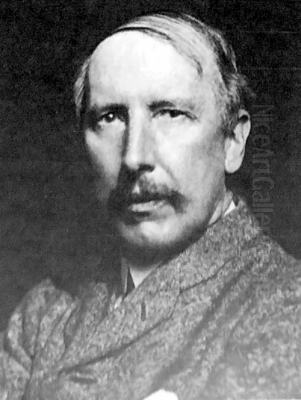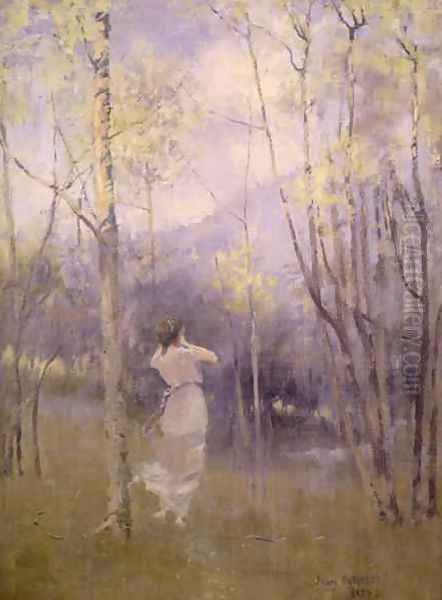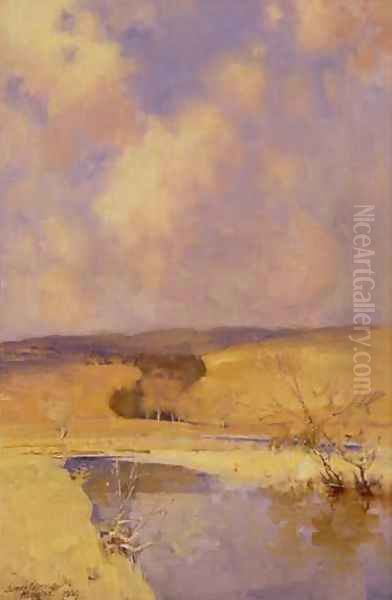
James Paterson (1854-1932) stands as a significant figure in the landscape of late nineteenth and early twentieth-century Scottish art. A painter celebrated for both his evocative depictions of the Scottish countryside and his insightful portraiture, Paterson was intrinsically linked with the progressive group of artists known as the Glasgow Boys. His work is characterized by a sensitivity to light, atmosphere, and the unique character of his native land, securing his place as an important contributor to the revitalization of Scottish painting during his era. Born into a period of artistic change, Paterson navigated the currents of European art while forging a distinctly personal and Scottish vision.
Early Life and Artistic Formation
James Paterson entered the world in Blantyre, near Glasgow, in 1854. His formative years coincided with Glasgow's rise as a major industrial and cultural centre, providing a dynamic backdrop for a budding artist. His initial artistic inclinations led him to the prestigious Glasgow School of Art, an institution that would nurture many of the key talents of his generation. The training received here provided him with a solid foundation in academic principles, but Paterson, like many of his contemporaries, soon felt the pull of newer artistic currents emanating from continental Europe, particularly France.
Driven by a desire to broaden his horizons and engage with contemporary art firsthand, Paterson travelled to Paris to continue his studies. He was among the first wave of young Glasgow artists to make this crucial journey, immersing himself in the vibrant Parisian art scene. He studied under figures like Jean-Paul Laurens and Jacquesson de la Chevreuse, absorbing the lessons of French academic training but also encountering the powerful influence of Realism and the burgeoning Impressionist movement. This exposure to artists who prioritized direct observation, contemporary subjects, and the effects of natural light proved transformative, shaping his artistic direction and aligning him with the progressive spirit that would soon define the Glasgow Boys.
The Glasgow Boys Connection

James Paterson became closely associated with the Glasgow Boys, a loose collective of artists who emerged in and around Glasgow during the 1880s and 1890s. This group, which included notable figures such as James Guthrie, John Lavery, E.A. Walton, George Henry, E.A. Hornel, Arthur Melville, Joseph Crawhall II, and W.Y. Macgregor, shared a common dissatisfaction with the perceived conservatism and sentimentality of the established Scottish art scene, particularly the Royal Scottish Academy in Edinburgh. They sought a more truthful, robust, and modern approach to painting, drawing inspiration from French Realism, the Barbizon School, and the tonal subtleties of James McNeill Whistler.
The Glasgow Boys did not adhere to a single manifesto, but they were united by their commitment to realism, their interest in capturing the effects of light and atmosphere, often through plein air (outdoor) painting, and their focus on rural subjects or scenes of modern life. They favoured strong tonal contrasts, square brushstrokes, and a directness of application that broke from the smoother finish of traditional academic work. Paterson was an integral part of this milieu, sharing their artistic aims and exhibiting alongside them. His time spent painting outdoors, particularly during his years in Moniaive, perfectly aligned with the group's ethos of direct engagement with the natural world. His work contributed significantly to the group's reputation for landscape painting that was both authentic and atmospherically charged.
Life and Work in Moniaive
A pivotal period in Paterson's career began around 1884 when he settled in the village of Moniaive, nestled in the picturesque landscape of Dumfriesshire in southwest Scotland. This move marked a deep immersion into the rural environment that would become the primary subject of his most celebrated works for nearly two decades. The rolling hills, winding rivers like the Nith, lush pastures, and changeable skies of Nithsdale and Galloway provided him with endless inspiration. Moniaive became not just his home but his open-air studio, allowing him to study the landscape intimately through all seasons and weather conditions.
During his time in Moniaive, Paterson produced a significant body of work that solidified his reputation as a master of Scottish landscape. He developed his characteristic style, focusing on capturing the subtle interplay of light and shadow, the specific atmospheric conditions, and the inherent mood of the place. His paintings from this period often depict quiet, contemplative scenes – a bend in a river, a path winding through fields, sheep grazing under a vast sky, or the village itself nestled in the valley. These works are imbued with a sense of tranquility and a deep affection for the region. His dedication to observing and rendering the nuances of this specific locale gave his landscapes a powerful sense of place and authenticity.
Artistic Style and Techniques: Landscape

Paterson's landscape paintings are renowned for their delicacy, luminosity, and atmospheric depth. He possessed a remarkable ability to capture the unique quality of Scottish light – often soft, diffused, and ever-changing. Rejecting the dramatic, Claudian compositions favoured by earlier generations of Scottish landscape painters like Horatio McCulloch, Paterson opted for more intimate, naturalistic views. His compositions feel unforced, drawing the viewer into the scene through subtle arrangements of form and tone. He was particularly adept at rendering water, capturing its reflections, transparency, and movement with fluid brushwork.
His palette was often characterized by subtle harmonies, favouring greens, blues, ochres, and greys that accurately reflected the colours of the Scottish countryside. However, he was also sensitive to the way light could transform these colours, infusing his scenes with warmth during sunrise or sunset, or capturing the cool, silvery light of an overcast day. His brushwork, while often described as fine, could also be varied and expressive, using texture to suggest the roughness of stone, the softness of foliage, or the fluidity of water. Influenced perhaps by Whistler's tonalism, Paterson paid great attention to the overall harmony and mood of his paintings, seeking to evoke an emotional response in the viewer rather than simply providing a topographical record.
Artistic Style and Techniques: Portraiture
While best known for his landscapes, James Paterson was also a highly accomplished portrait painter. The source material notes his skill as a "keen portraitist," capable of capturing the "subtle facial expressions" of his sitters. His approach to portraiture likely shared the commitment to realism and psychological insight seen in the work of fellow Glasgow Boys like James Guthrie. He painted portraits throughout his career, depicting friends, family members, local figures from Moniaive, and likely undertaking commissions later in his career, especially after moving to Edinburgh.
His portraits are characterized by a sensitivity to character and a focus on capturing the individuality of the sitter. Rather than relying on elaborate props or settings, Paterson often favoured relatively simple backgrounds, allowing the face and posture of the subject to convey personality and presence. His brushwork in portraits could be both controlled, rendering features with precision, and fluid, suggesting the texture of clothing or hair. He aimed for a sense of lifelikeness and inner presence, seeking to reveal something of the sitter's thoughts or disposition through careful observation of their features and expression. His portraits provide a valuable counterpoint to his landscapes, showcasing his versatility and his keen eye for human detail.
The Role of Photography
Intriguingly, James Paterson incorporated photography into his artistic practice, a forward-thinking approach shared by several artists of his time, including Edgar Degas and other members of the Glasgow Boys. The source text mentions that some of his photographs "later became the basis for his painting creation." This suggests that Paterson used photography not merely as a passive recording device but as an active tool within his creative process. He might have used photographs to capture fleeting effects of light and shadow that were difficult to record in lengthy outdoor painting sessions, or to study compositional possibilities before committing them to canvas.
Photography could also have aided in capturing details of landscape or figures, providing reference material back in the studio. This integration of photography does not diminish the artistic merit of his paintings; rather, it highlights his willingness to embrace modern technologies in service of his artistic vision. It allowed him to explore different ways of seeing and composing, potentially influencing the framing and cropping found in some of his painted works. His use of photography underscores his position as a modern artist, open to new methods while remaining focused on traditional genres like landscape and portraiture.
Representative Works
Several paintings stand out as representative of James Paterson's artistic achievement. "The Last Turning, Nithsdale" (c. 1885) is perhaps one of his most famous works from the Moniaive period. It depicts a quiet country road winding alongside the River Nith under a soft, luminous sky. The painting masterfully captures the tranquil atmosphere of the Dumfriesshire landscape, showcasing Paterson's skill in rendering subtle tonal variations, the reflective quality of water, and the gentle diffusion of light. The composition leads the viewer's eye gently into the distance, evoking a sense of peace and contemplation.
Another notable landscape is "Windy Weather," which demonstrates his ability to capture more dynamic atmospheric conditions. Here, the brushwork might be looser, the clouds more dramatic, conveying the feeling of wind moving through the landscape. Works simply titled "Moniaive" often depict the village itself, capturing its relationship to the surrounding hills and river, showcasing his deep connection to the place. His portraits, such as those of family members or local dignitaries, while perhaps less widely reproduced, demonstrate his skill in capturing character, often with a directness and lack of affectation typical of the Glasgow School's approach to portraiture. These works collectively illustrate the core themes and stylistic qualities of his oeuvre.
Later Career and Recognition
In 1906, James Paterson made a significant move from the rural seclusion of Moniaive to Edinburgh, the capital city and the traditional centre of the Scottish art establishment. This relocation marked a new phase in his career. While he continued to paint landscapes, often drawing inspiration from the East Lothian coast or revisiting earlier themes, his presence in Edinburgh likely led to an increase in portrait commissions. He became an active and respected member of the city's artistic community.
His standing within the Scottish art world was formally recognized through his involvement with key institutions. He had been elected an Associate of the Royal Scottish Academy (ARSA) in 1896 and became a full Academician (RSA) in 1910. His expertise in watercolour painting was acknowledged early on; he was elected to the Royal Scottish Society of Painters in Watercolour (RSW) in 1885 and served as its President from 1922 until his death in 1932. These roles cemented his position as a senior figure in Scottish art. During his later years, Paterson also achieved growing international recognition, with his works being exhibited beyond Scotland, reflecting the broader appreciation for the achievements of the Glasgow Boys and Scottish painting in general.
Influences and Contemporaries
James Paterson's art developed within a rich context of influences and interactions with contemporary artists. The naturalism and focus on rural life found in the work of the French Realist Jules Bastien-Lepage was a profound influence on many of the Glasgow Boys, including Paterson. The atmospheric sensitivity of the Barbizon School painters, particularly Jean-Baptiste-Camille Corot, also resonates in Paterson's handling of light and mood. Furthermore, the aesthetic principles and tonal harmonies championed by the American expatriate artist James McNeill Whistler left a distinct mark on the Glasgow group's approach to colour and composition.
Within Scotland, the towering figure of William McTaggart, known for his expressive and light-filled seascapes and landscapes, provided an important precedent for Paterson's generation in breaking away from staid academic conventions. Paterson's direct contemporaries and colleagues within the Glasgow Boys – James Guthrie, John Lavery, E.A. Walton, George Henry, E.A. Hornel, Arthur Melville, Joseph Crawhall II, and W.Y. Macgregor – formed his most immediate artistic circle, sharing ideas and exhibiting together. Looking slightly beyond, the work of the Newlyn School painters in Cornwall, such as Stanhope Forbes and Frank Bramley, shared similar interests in rural realism and plein air painting. While distinct, the later Scottish Colourists like Samuel Peploe, F.C.B. Cadell, and Leslie Hunter, built upon the foundation of colour and light exploration laid by Paterson's generation, albeit with a bolder, more Post-Impressionist sensibility. Even the broader context of French Impressionism, through artists like Claude Monet, informed the era's preoccupation with capturing fleeting moments of light and atmosphere.
Legacy and Historical Evaluation
James Paterson's legacy lies primarily in his significant contribution to the Glasgow School and, through it, to the broader narrative of Scottish art. He was a key player in the movement that challenged the dominance of the Edinburgh establishment and brought a fresh, modern perspective to Scottish painting, particularly in the genre of landscape. His works are celebrated for their lyrical beauty, their authentic portrayal of the Scottish countryside, and their masterful handling of light and atmosphere. He successfully synthesized influences from continental Europe with a deeply personal connection to his native land.
His paintings from the Moniaive period are considered among the finest examples of Scottish landscape painting from the late nineteenth century. They capture a specific sense of place with sensitivity and nuance, avoiding overt sentimentality while still conveying deep affection for the rural environment. As a skilled portraitist, he also contributed to the Glasgow Boys' reputation for strong, characterful depictions of individuals. Today, his works are held in major public collections, including the National Galleries of Scotland, Glasgow Museums, and the Hunterian Art Gallery at the University of Glasgow, ensuring his continued recognition. Art historians regard him as a pivotal figure who helped bridge the gap between traditional landscape painting and the more modern approaches that would follow in the twentieth century.
Conclusion
James Paterson was an artist of quiet distinction and enduring quality. As a prominent member of the Glasgow Boys, he played a vital role in steering Scottish art towards modernity, embracing realism, plein air painting, and a sophisticated understanding of tone and light influenced by contemporary European art. His extended period in Moniaive yielded a remarkable body of landscape work that captured the essence of the Dumfriesshire countryside with unparalleled sensitivity and atmospheric grace. Complemented by his insightful portraiture, Paterson's oeuvre demonstrates versatility and a consistent commitment to artistic integrity. His legacy endures in his beautiful depictions of Scotland and his contribution to one of the most innovative periods in the nation's art history. He remains a respected and admired figure, a painter who truly captured the soul of the Scottish landscape.